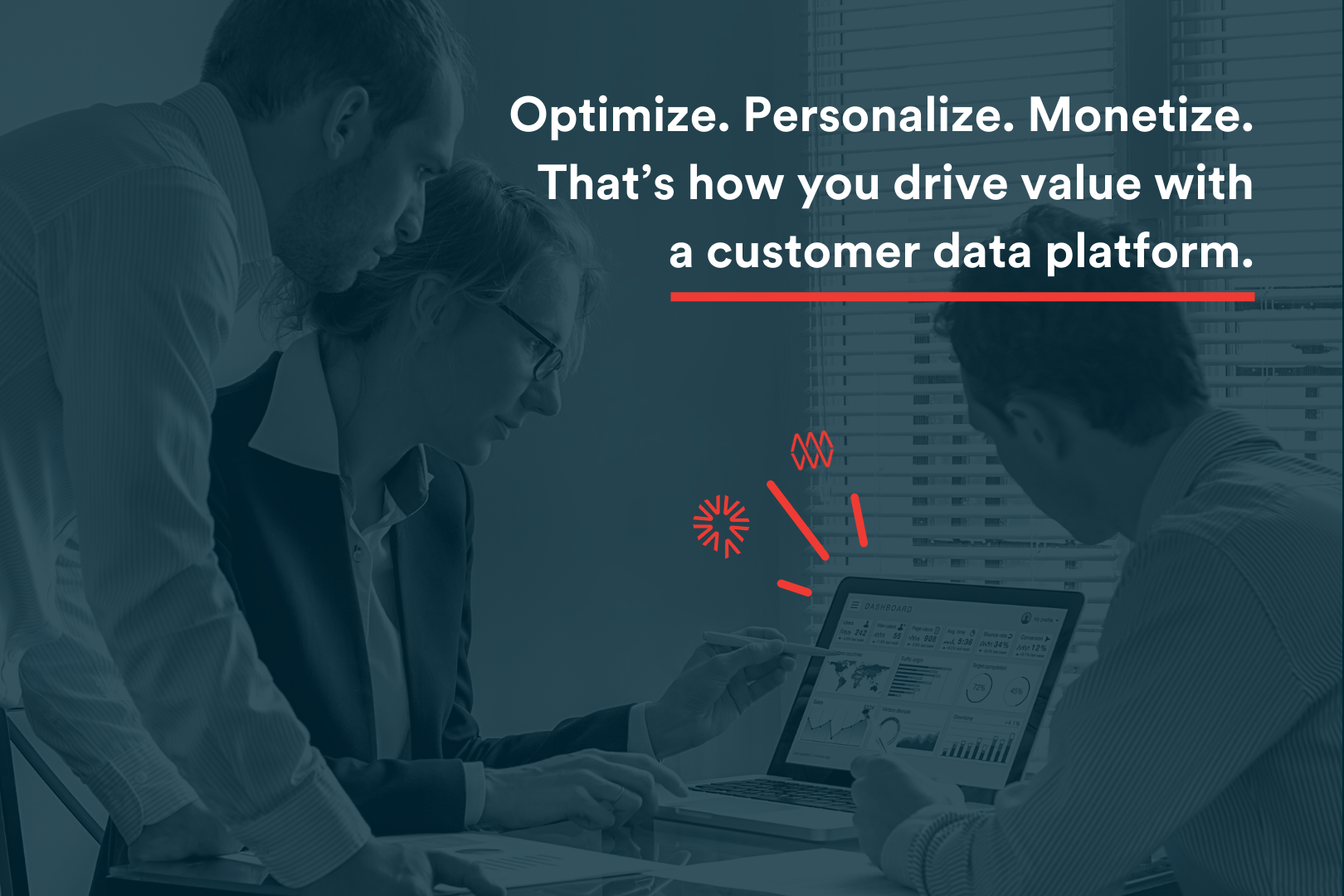Knowing the habits and behaviors of your business’s target audience is key to providing an experience that converts prospects into customers and customers into evangelists for your company.
Enter the customer data platform.
A customer data platform is a type of software that unites data from across multiple sources into one system in order to demonstrate trends. It does this through aggregating and analyzing data from known, as well as anonymous, visitors.
With these functions in place, it becomes possible for a business, often represented by a marketing analyst, to come up with actionable insights that can influence operations for the better.
Customer data platforms can drive value for your marketing and business operations in three key ways: optimization, personalization, and monetization. Below, we explore how businesses can use customer data platforms to achieve these aims.
Plus: stick around to the end, where we’ll touch briefly on the dark side of customer data platforms and how the industry could evolve as privacy concerns take center stage.
Optimization
One major thing a customer data platform enables your business to do is refine your product or, at the very least, the way you market your product.
Assumptions about your customers or your prospects are essential when launching a new business or a new product. Because you don’t necessarily have a wide customer data set to draw from, you’re reliant on market research and careful deliberation to determine who you think your customers are and how they will react to your product.
A customer data platform allows you to confirm or rethink those assumptions, and that’s where optimization comes in. Once customer data platforms have aggregated data from across multiple sources, not dissimilar to how a data warehouse might pull from multiple data lakes, it’s possible to use that data to improve aspects of your business or product.
Let’s assume, for instance, that your company approached the development of an application and the subsequent marketing of the application with desktop as the primary focus (something we wouldn’t recommend but that can still happen). A customer data platform might make you realize, for instance, that your current and prospective customers primarily use their mobile devices to interact with your app and similar apps in your space.
This would cause you to rethink your initial approach and optimize the product with a mobile-first mindset. What’s more, it would open up a new set of sprint goals for your development team, who could emphasize deployment of updates across mobile platforms, jumping the line ahead of the stable but less-used desktop app.
Mobile versus desktop is just one potential takeaway. Customer data platforms, in part because they’re aggregated, let you see things you would never get from your in-house analytics software or customer relationship management (CRM) tool alone.
What are your customers’ email habits? What motivates them to make a purchase? What websites do they visit? What kinds of products do they buy? All of this and more provides a window into your customers’ minds that lets you optimize your offerings to meet them where they are, rather than expect them to meet you where you are.

Personalization
After optimizing your product and the marketing of your product, the next thing you can focus on is personalizing your product.
The more you know about your customers, the easier it is to provide deep customization happening in the background, without the individual even knowing it’s taking place. Your customer data platform could reveal that you have multiple audience segments, and therefore you can adapt your products to suit each customer “persona” rather than relying on a one-size-fits-all approach.
This helps you increase the stickiness of your product and appeal to those who otherwise might feel like you’re not talking to them.
From a marketing standpoint, this is one of the great benefits of digital versus traditional media. With something like a billboard or a radio ad, you’re stuck with one message for at least 30 days, and that message is the same no matter who drives by the sign or listens to the station.
Not so with digital media and digital products. You can test and alter things on the fly, adapting as necessary to meet geographic and demographic idiosyncrasies to show you’re ready to solve the unique problems of a specific individual.
The best part about this personalization is that, to the outside observer, i.e. a customer, it all appears seamless. They don’t know that the way you present an offer or display certain things has been adjusted to match their preferences. All they know is they’re getting an intuitive experience that fits their expectations like a glove.
Monetization
Ultimately, a better understanding of your customers and the journey they take will help you monetize your product.
A customer data platform might reveal that a majority of visitors are leaving items in the cart, or they’re exiting a page that should otherwise be converting them into paying subscribers. These insights allow you to drill down and more carefully analyze what’s going on to cause that break in the chain, to solve why there’s a mismatch between your expectations and the reality of the customer journey.
It can also help you design and deploy product offers across multiple channels best suited to your customers’ interests. Does your customer data platform suggest that a majority of your users listen to Spotify? Targeted audio ads might drive new prospects to your website. Are your users web-savvy enough to turn on ad blockers? A social media, SEO or influencer-based marketing campaign might be the right move to draw in new customers who would otherwise never see ads.
Even in-app purchases can be refined thanks to customer data platforms. Editing something as simple as the placement of a button or the way an offer is phrased could be enough to switch “Basic” customers to “Premium” customers. You can similarly play with pricing, timing of trial periods, etc., to find the sweet spot your customers are willing to buy in to.
Data will help inform your pricing and selling strategy and turn your product or business into a moneymaker.
Demonization?
There’s one final “zation” we want to call out, and that’s demonization.
Governments, tech providers and consumers are more attuned to privacy policies than ever before. As a result, the collection of customer data, especially by behemoths like Facebook, is under the microscope.
We envision that the coming years will experience a sea change in how data is collected, spurred in no small part by tech giants like Apple cracking down on tracking users across multiple apps.
Depending on how legislation shakes out and how leading tech companies approach data collection, customer data platforms will need to evolve, especially if they rely on third parties and in-depth tracking across sites and apps. In-product tracking may remain relatively unchanged, with the caveat that you may be expected to ask permission to track a user within your site or app. Conversely, you may need to explicitly say that the user grants tracking permission by use of the app, with the risk that you might lose that user if they don’t agree.
Customer data platforms remain powerful tools for your marketing and business intelligence teams, but you’d be doing yourself a disservice by not keeping abreast of privacy changes that could affect data collection. Ultimately, doing so is yet another way to ensure you’re driving value to your business.
(For a great explanation of what a customer data platform is and how it works, we’d recommend this article from marketing software vendor Hubspot.)





